A NEST-based framework unlocks massively parallel simulation of networks of multicompartment neurons with customizable subcellular dynamics
While the implementation of learning and memory in the brain is governed in large part by subcellular mechanims in the dendrites of neurons, large-scale network simulations featuring such processes remain challenging to achieve. This can be attributed to a lack of appropriate software tools, as neuroscientific simulation software focuses on the one hand on highly detailed models, and on the other hand on massive networks featuring point-neurons. Here, we fill this gap by implementing a framework for the massively parallel simulation of simplified dendrite models with customizable subcellular dynamics. To achieve this, we leverage the NEural Simulation Tool (NEST), the neuroscientific reference with respect to efficient massively parallel simulations of point neuron networks. By co-opting the already existing model descriptions language NESTML, we generate C++ code implementing user-configurable subcellular dynamics. Through benchmarking and profiling, we show that the generated models run efficiently, leading to scalable NEST network simulations. We demonstrate relevant functionalities by showing that a key sensory computation – the association of top-down context arriving at distal dendrites in layer 1 and feedforward sensory input arriving perisomatically – can be achieved in a single shot fashion through apical calcium dynamics. Our work thus unlocks the study of how dendritic processes shape learning, and in particular of how brain-wide communication through long-range, layer 1-targetting connections steers perisomatic plasticity. ### Competing Interest Statement The authors have declared no competing interest. Helmholtz Association of German Research Centres, https://ror.org/0281dp749 Italian Ministry for Universities and Research (MUR), CUP I53C22001400006, CUP B51E22000150006
The second publication focuses on the NESTML and NEST-based simulation framework for multicompartment models. Now, you can define scalable network simulations featuring dendritic processes with NEST! www.biorxiv.org/content/10.1...
09.07.2025 07:25 — 👍 1 🔁 0 💬 0 📌 0
The neural analysis toolkit unifies semi-analytical techniques to simplify, understand, and simulate dendrites
While simulating compartmental dynamics in response to various input patterns is the prevalent technique for understanding dendritic computation, a great deal can be learned from classical analytical methods that provide solutions for the dendritic voltage. For example, such solutions are needed to simplify spatially extended neuron models, to understand frequency-dependent response properties, to elucidate the interaction between synaptic inputs, and hence to reveal the effective compartmentalization of dendrites into functional subunits. Nevertheless, these methods have not been implemented in modern software tools. This works describes the NEural Analysis Toolkit (NEAT), a Python toolbox that implements classical algorithms to compute response properties of spatially extended neuron models, and that leverages these algorithms to simplify them. Packaged with this are a range of useful utilities to plot morphologies and spatial quantities defined on the morphology, to distribute locations on the morphology, and to select parts of the morphology to e.g. apply morphological ablations or alter the membrane properties. The resulting models can be exported to NEURON and NEST, two commonly used simulators, the former focused on detailed single neuron model simulations, and the latter geared towards distributed network simulations. As a consequence, this toolbox provides a missing link between single neuron computation and large-scale network analysis, substantially facilitating the study of the role of dendritic computation in shaping emergent network dynamics. NEAT is available through pip under the name ‘nest-neat’, or from its source code (<https://github.com/nest/NEAT>), which is provided under the GNU General Public License. Furthermore, support for NEAT is provided on its GitHub page and through the NEST user mailing list (users{at}nest-simulator.org). ### Competing Interest Statement The authors have declared no competing interest. Helmholtz Association of German Research Centres, https://ror.org/0281dp749
Using the NEural Analysis Toolkit (NEAT), you can create simplified neuron models from detailed ones. This toolbox provides a missing link between single neuron computation and large-scale network analysis! www.biorxiv.org/content/10.1...
09.07.2025 07:25 — 👍 1 🔁 0 💬 1 📌 0
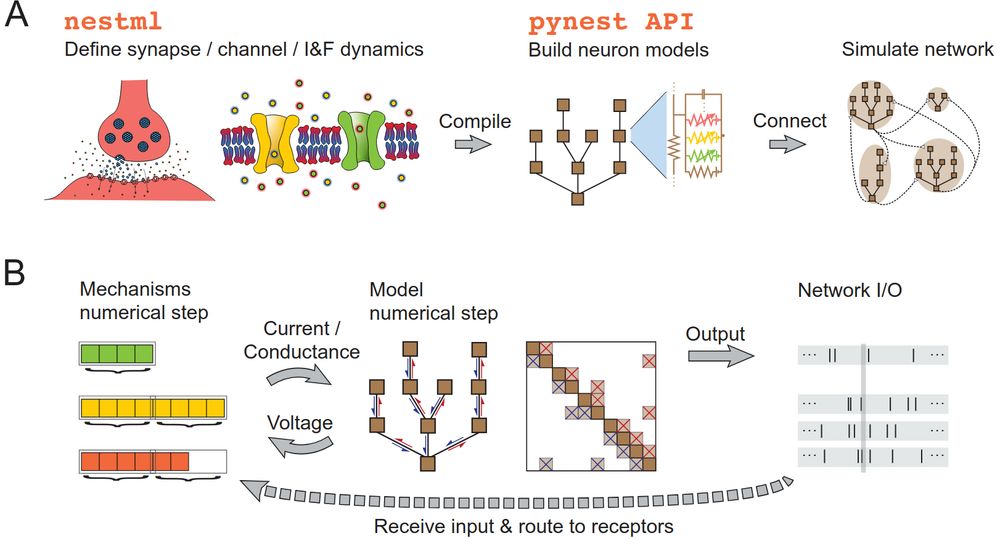
Overview of the compartmental simulation toolchai
Do you also want to start simulating large-scale networks with dendrites? Check out these preprints from Willem Wybo and colleagues!
#nestsim
09.07.2025 07:25 — 👍 4 🔁 0 💬 1 📌 0
GitHub - Wiss/edsnn: spiking neural networks simulations with energy-dependent neuron and synapse models
spiking neural networks simulations with energy-dependent neuron and synapse models - Wiss/edsnn
They used NEST and NESTML to develop an energy-dependent leaky integrate-and-fire neuron model and a three-factor synaptic plasticity rule incorporating postsynaptic energy as a 3rd factor, enabling sensitivity tuning to energy imbalance.
Full source code is available 🎉: github.com/Wiss/edsnn
03.07.2025 08:07 — 👍 0 🔁 0 💬 0 📌 0
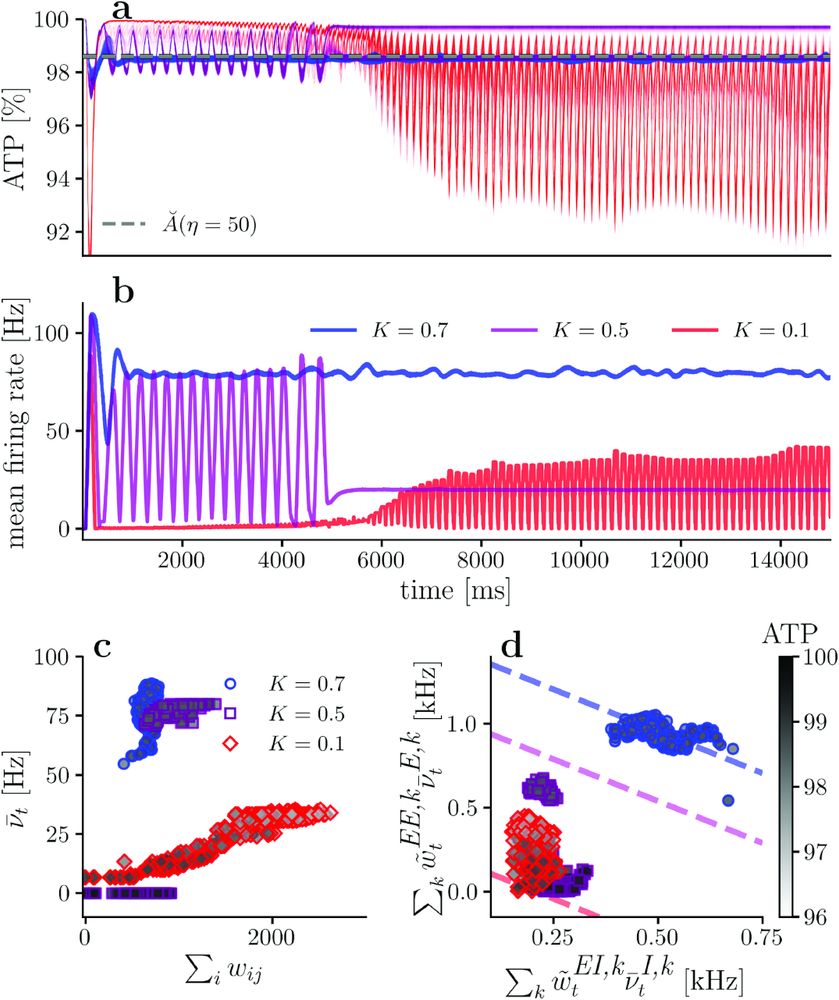
Available energy and firing rate for different ATP production impairment.
Very cool paper from the University of Chile investigating how local metabolic constraints influence the structure and activity of spiking neural networks (SNNs)
journals.plos.org/ploscompbiol... #nestsim
03.07.2025 08:04 — 👍 7 🔁 2 💬 1 📌 0
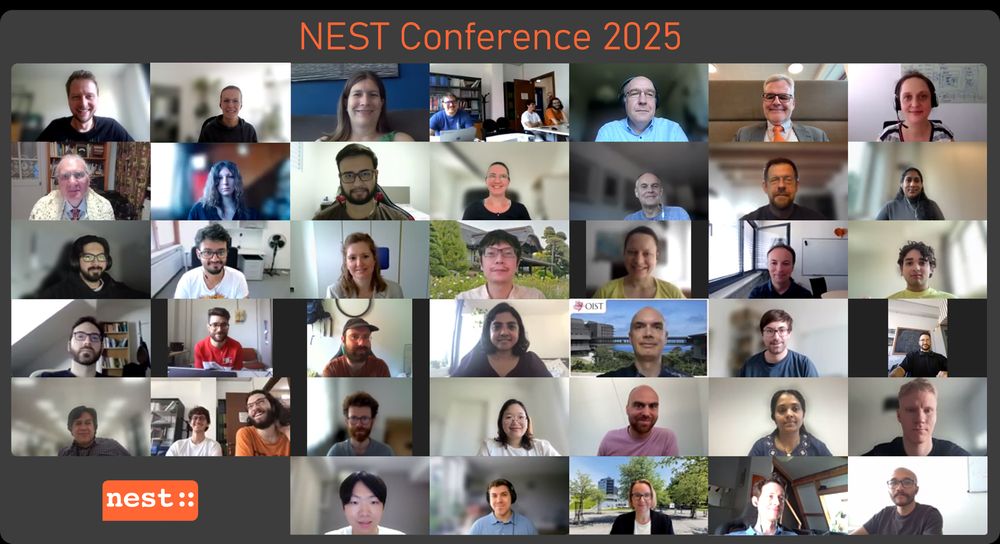
Group photo of NEST conference participants
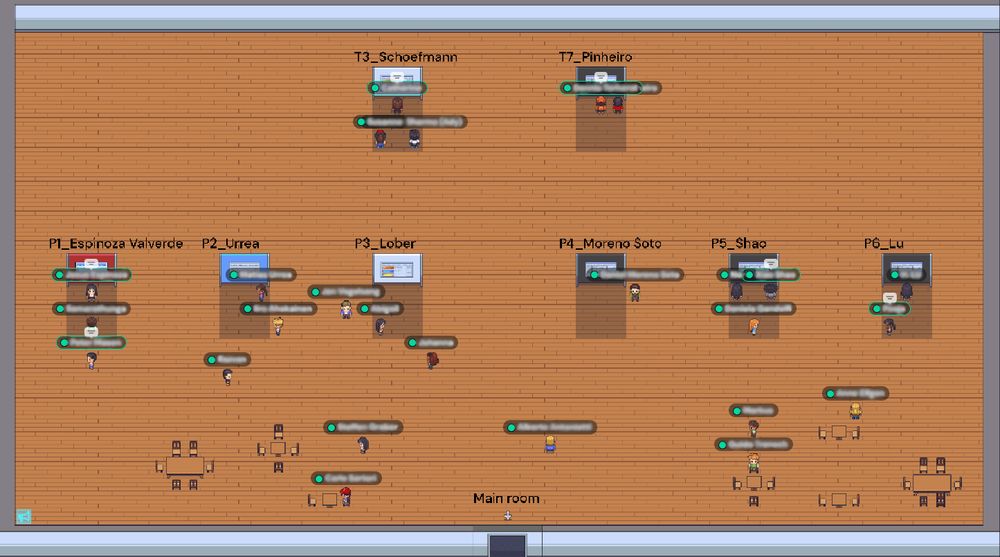
Virtual poster session in gather.town
The NEST virtual conference 2025 was another great success! Thanks to all speakers and participants for an inspiring conference! nest-simulator.org/conference
25.06.2025 08:03 — 👍 2 🔁 0 💬 0 📌 0

Rendered output from a neuron model and a synapse model example in NESTML
We are excited to present the new paper on NESTML, a user-friendly language and toolchain for simulating SNNs with advanced plasticity rules.
NESTML makes it easy for anyone to create and run models across platforms, enhancing accessibility and reproducibility in neuroscience! tinyurl.com/2x7vcc48
10.06.2025 12:48 — 👍 4 🔁 1 💬 0 📌 1
There is still time to register for the virtual NEST conference 2025, taking place 17-18 June! Get to know the NEST Simulator community and learn about the latest in neural simulation technology! Registration and program available here: nest-simulator.org/conference #nestsim
02.06.2025 07:16 — 👍 2 🔁 0 💬 0 📌 0
CNS 2025
Want to learn more? - check out the NEST virtual conference 2025 (nest-simulator.org/conference) or the CNS meeting (www.cnsorg.org/cns-2025), which will offer workshops on integrating dendritic compartments in large-scale network simulations!
20.05.2025 12:11 — 👍 0 🔁 1 💬 0 📌 0
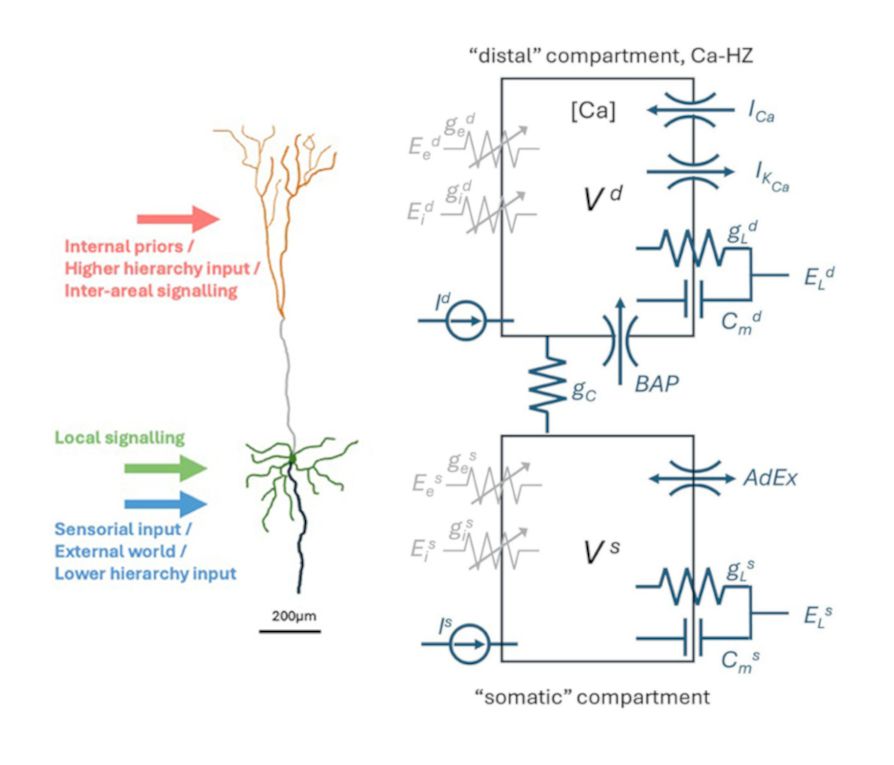
Cortical pyramidal cell and schematic of the Ca-AdEx neuron
We are thrilled to share Elena Pastorelli and Pier Stanislao Paolucci’s amazing work on modeling dendritic calcium dynamics in large-scale network simulations using NEST'S multi-compartment modeling framework developed by Willem Wybo (tinyurl.com/caldyn) #nestsim
20.05.2025 12:09 — 👍 6 🔁 1 💬 1 📌 0
The NEST virtual conference is gearing up! Join us June 17-18, 2025 for a chance to exchange ideas and learn about developments in simulation science! Interested in contributing? The abstract submission deadline has been extended to **April 30**. Visit nest-simulator.org/conference. #nestsim
25.04.2025 13:07 — 👍 2 🔁 2 💬 0 📌 0
Hello, BlueSky! We're thrilled to join this vibrant community! Stay tuned for updates on our latest software releases, upcoming conferences and workshops, and groundbreaking research with the NEST simulator! #nestsim
25.04.2025 12:23 — 👍 5 🔁 3 💬 0 📌 1
As a member of the Helmholtz Association with 7,000 employees, we conduct research into the possibilities of a digitized society, a climate-friendly energy system, and a resource-efficient economy.
www.fzj.de
EBRAINS is an open research infrastructure that gathers high-quality research data, tools and computing facilities for brain-related research, built with interoperability at the core.
Co-founder of thesify.ai - responsible AI for students and scientists
Computational neuroscientist, AI researcher & entrepreneur.
Co-author of the Neural Simulation Tool NEST
Say hi.
www.thesify.ai
PhD student @rwth.bsky.social and @fz-juelich.de in computational neuroscience and neuromorphic computing | Cognitive maps, hippocampus, navigation, inductive biases
chronic reader of old papers. dynamical systems & computation & bio-plausible learning. curr: @flatiron ccn, msc: comp neuro @tubingen, bsc: EE.
Theoretical Neuroscientist, Columbia University
comp neuro, neural manifolds, neuroAI
asst prof NYU CNS → Harvard Physics, Kempner Institute, Center for Brain Science (Fa ’25)
proj leader Flatiron Institute
https://sites.google.com/site/sueyeonchung/
Assistant Professor, Psychology & Data Science @ NYU | Working on brains & climate (separately) | Author of "Models of the Mind: How physics, engineering, and mathematics have shaped our understanding of the brain" http://tinyurl.com/h9dn4bw7
Associate Professor at Harvard & Kempner Institute. Applying computational frameworks & machine learning to decode multi-scale neural processes. Marathoner. Rescue dog mom. https://www.rajanlab.com/
Postdoctoral researcher at the University of Montreal and Mila - Quebec AI Institute. Amateur writer.
Computational neuroscientist.
Senior Lecturer at Ulster University in the Great City of Derry, Northern Ireland.
"not articulate enough"
https://odonnellgroup.github.io
Neuroscientist, in theory. Studying sleep and navigation in 🧠s and 💻s.
Assistant Professor at Yale Neuroscience, Wu Tsai Institute.
An emergent property of a few billion neurons, their interactions with each other and the world over ~1 century.
|| assistant prof at University of Montreal || leading the systems neuroscience and AI lab (SNAIL: https://www.snailab.ca/) 🐌 || associate academic member of Mila (Quebec AI Institute) || #NeuroAI || vision and learning in brains and machines
Professor of Applied Physics at Stanford | Venture Partner a16z | Research in AI, Neuroscience, Physics
Computational neuroscientist, Assistant Professor at @sinaibrain.bsky.social, Mount Sinai. Views are my own. New York, NY. He/him. schafferlab.com
Professor at the Gatsby Unit and Sainsbury Wellcome Centre, UCL, trying to figure out how we learn
NeuroAI, vision, open science. NeuroAI researcher at Amaranth Foundation. Previously engineer @ Google, Meta, Mila. Updates from http://neuroai.science
Professor, Department of Psychology and Center for Brain Science, Harvard University
https://gershmanlab.com/
assoc prof, uc irvine cogsci & LPS: perception+metacognition+subjective experience, fMRI+models+AI
meta-science, global education, phil sci
prez+co-founder, neuromatch.io
fellow, CIFAR brain mind & consciousness
meganakpeters.org
she/her 💖💜💙 views mine
Picower Professor of Neuroscience @ MIT
Cognitive neuroscience, executive brain functions, consciousness, brainwave dynamics, and bass guitar. You know, the good stuff.
https://ekmillerlab.mit.edu/





